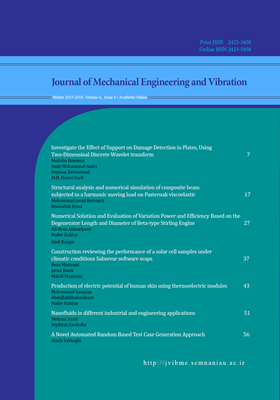Numerical Solution and Evaluation of Variation Power and Efficiency Based on the Degenerator Length and Diameter of Beta-type Stirling Engine
Subject Areas : Termodynamic
Nader Rahbar
1
![]() ,
Hadi Kargar Sharifabad
2
,
علیرضا احمد پور
3
,
Hadi Kargar Sharifabad
2
,
علیرضا احمد پور
3
1 - استادیار، مرکز تحقیقات انرژی و توسعه پایدار، واحد سمنان، دانشگاه آزاد اسلامی، سمنان، ایران
2 - استادیار، مرکز تحقیقات انرژی و توسعه پایدار، واحد سمنان، دانشگاه آزاد اسلامی، سمنان، ایران
3 - دانشجو
Keywords: Mathematical Modeling, Isotherm, Stirling engine, Degenerator,
Abstract :
The most important part of the Stirling engine that has an important role in improving efficiency, heat recovery. Stirling cycle heat recovery is one of the important parts of that model because of the influence of various parameters is very complex. In terms of physical structure, heat recovery from stainless steel sheet, stainless steel net or stacked bars, are made. Over half of the engine cycle, heat recovery heat like a sponge to absorb the heat of the operating gas. In the other half cycle, recovery of heat after the gas, so less heat to ward off the cold the engine, there will be a way to increase engine efficiency. Therefore, the recovery Stirling engine reduces heat loss and thus increasing the engine's efficiency. The development of an appropriate thermodynamic model for beta type Stirling engine, has been the recovery area. This model, predict and optimize power output and performance parameters based on the physical conditions and geometric Stirling engine regenerator requirements. For this purpose, the numerical solution of beta type Stirling engine uses isothermal and adiabatic model is done. To validate the results, the geometric and functional Stirling engine manufactured by General Motors used and the results were compared with published values.


